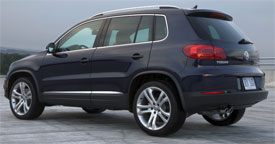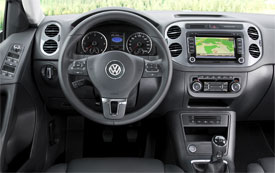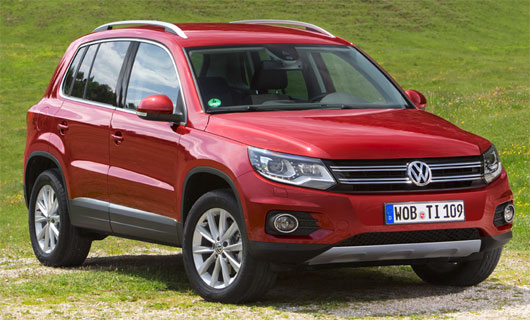2012 Volkswagen Tiguan
With all of the compact crossovers that have arrived over the last few years it’s not hard to overlook the Volkswagen Tiguan. Still, the Tiguan has brought a touch of luxury to compact crossovers. And with Volkswagen’s goal of a huge jump in sales here, the Tiguan is a very important vehicle for getting there. Still, in a very crowded segment, does the redesigned Tiguan offer enough to finally make it a volume player?
The 2012 Volkswagen Tiguan may be lost in that sea of small crossovers, but with a host of updates, it looks to have found its bearings and may finally be headed to the “land of increased sales.”
Wearing a nicer outfit is always a good way to attract attention, and the Tiguan’s updated threads start with a spiffy new front end treatment. A fresh horizontal-bar grille has been added to match the rest of the Volkswagen lineup. It integrates nicely with the new clear-lens, swept back headlight housings, though our SE test did not feature the up-level SEL’s Bi-Xenon’s and LED daytime running lights.
Down low, there are new honeycomb grille openings and a simulated skid plate. The rear fascia has been updated as well with a smoother look and more distinctive tail lamps.
 But, between the two ends things remain much the same, save for some new wheel options. Silver cargo rails adorn the roof, and there’s a hatch-mounted rear spoiler. We find the overall theme more classy than youthful or sporting. Our front wheel drive SE rides on 18-inch alloys. And that ride is a very compliant one. Road manners are impressive, as the Tiguan is both smooth and comfortable. The engine makes good power for both passing and sprints off the line.
But, between the two ends things remain much the same, save for some new wheel options. Silver cargo rails adorn the roof, and there’s a hatch-mounted rear spoiler. We find the overall theme more classy than youthful or sporting. Our front wheel drive SE rides on 18-inch alloys. And that ride is a very compliant one. Road manners are impressive, as the Tiguan is both smooth and comfortable. The engine makes good power for both passing and sprints off the line.
There’s little new under the hood. The same 200-horsepower, turbocharged 2-liter as before. It makes a healthy 207 pound feet of torque using direct injection. Though most of our staff found it even peppier, thanks to very immediate throttle response, some complained it sounds too much like a diesel. By, the way, a true diesel Tiguan for the U.S. is still years away.
What has changed is a heavily revised 6-speed automatic transmission that boosts Government Fuel Economy Ratings to 22-City and 27-Highway. Expect to average about 24 miles-per-gallon of Premium in daily driving. That makes the Energy Impact Score better than average at 13.7-barrels of oil consumed per year, with annual CO2 emissions of 6.1-tons. By the way, a 6-speed manual is also available.
At the track, our automatic Tiguan sprinted to 60 in 8.0-seconds flat. Good for any CUV. Soft, but reasonably quick shifts helped to propel us to the end of the ¼ mile in 16.3-seconds at 88 miles-per-hour, feeling solid and stable the entire way. As before, through the cones, we found the Tiguan to be quite entertaining. There’s good steering feel even with electric assist. Tires are grippy and there’s ample feedback. Weight is well balanced and turn-ins were quick. Tiguan feels very much like the Golf that it’s based on.
Up front there’s a fully independent strut type suspension, and in the rear there’s a multi-link setup. Even when speeds get ratcheted up to sport sedan territory, the Tiguan stays plenty stable, inspiring much confidence; though it does exhibit a fair amount of body roll.
Brakes are also impressive, with good response, and good numbers stopping from 60 in 126-feet. Though there is a lot of nose dive, and occasional rear wheel lock-up, but hard stops were consistently smooth and straight.
 The interior design of the Tiguan is very clean, and refreshingly simple. Materials quality is well above class average. Most everything inside is carryover save for some new trim pieces. Our SE model came equipped with leatherette seating, panoramic sunroof and easy to use touch-screen navigation. One complaint that most of our staff shared is seats that are are a bit on the hard side, as you feel like you’re sitting on them rather than in them.
The interior design of the Tiguan is very clean, and refreshingly simple. Materials quality is well above class average. Most everything inside is carryover save for some new trim pieces. Our SE model came equipped with leatherette seating, panoramic sunroof and easy to use touch-screen navigation. One complaint that most of our staff shared is seats that are are a bit on the hard side, as you feel like you’re sitting on them rather than in them.
Rear seat room is adequate and cargo space is not as generous as many rivals, making the Tiguan more for young couples or empty nesters, than for growing families. Rear seats do slide and recline as well as fold flat, expanding the cargo space from 23.8 cubic-feet to 56.1. The front passenger seat also folds flat for hauling longer items.
Though pricing remains a bit high for compact utes, they are down a little from last year, with a base front-wheel-drive Tiguan S starting at $23,660. The mid-level SE stickers for $29,455, while the fully loaded SEL rings in at a lofty $34,795. 4Motion all-wheel-drive is available on all models.
While the 2012 Volkswagen Tiguan might still be too pricey to be a true volume player, for those who want to crank up the fun-to-drive volume, it’s the perfect ticket. To us, that, and the overall quality aura of the Tiguan, make this compact CUV well worth the extra cash.
Specifications
- Engine: 2-liter
- Horsepower: 200
- Torque: 207 lb-ft.
- 0-60 mph: 8.0 seconds
- 1/4 mile: 16.3 seconds @ 88 mph
- EPA: 22 mpg city/ 27 mpg highway
- Energy Impact: 13.7 barrels of oil/yr
- CO2 Emissions: 6.1 tons/yr






